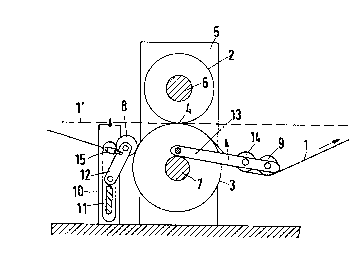Some of the information on this Web page has been provided by external sources. The Government of Canada is not responsible for the accuracy, reliability or currency of the information supplied by external sources. Users wishing to rely upon this information should consult directly with the source of the information. Content provided by external sources is not subject to official languages, privacy and accessibility requirements.
Any discrepancies in the text and image of the Claims and Abstract are due to differing posting times. Text of the Claims and Abstract are posted:
| (12) Patent: | (11) CA 2116599 |
|---|---|
| (54) English Title: | CALENDER ASSEMBLY |
| (54) French Title: | ASSEMBLAGE DE CALANDRES |
| Status: | Expired and beyond the Period of Reversal |
| (51) International Patent Classification (IPC): |
|
|---|---|
| (72) Inventors : |
|
| (73) Owners : |
|
| (71) Applicants : |
|
| (74) Agent: | KIRBY EADES GALE BAKER |
| (74) Associate agent: | |
| (45) Issued: | 1997-11-11 |
| (22) Filed Date: | 1994-02-28 |
| (41) Open to Public Inspection: | 1994-10-30 |
| Examination requested: | 1994-02-28 |
| Availability of licence: | N/A |
| Dedicated to the Public: | N/A |
| (25) Language of filing: | English |
| Patent Cooperation Treaty (PCT): | No |
|---|
| (30) Application Priority Data: | ||||||
|---|---|---|---|---|---|---|
|
In a calender assembly for treating a web of material
(1) in a nip (4) formed by a pair of press rolls (2, 3), at
least one roll (3) is heated. In front of and/or behind
the nip (4) there is at least one additional roll (8, 9,
14) which can be displaced into the path of the web of
material (1) in such a way that the angle of wrap of the
web of material (1) at the heated press roll (3) increases.
In this way, easy and quick introduction of the web of
material is made possible. Further, the heat losses of the
heated roll are reduced.
Dans la calandre de traitement d'un matériau en bande continue (1), à la ligne de contact entre une paire de rouleaux de presse (2, 3), au moins un rouleau (3) est chauffé. l'avant et/ou à l'arrière de la ligne de contact (4), il y a au moins un rouleau supplémentaire (8, 9, 14) qui peut être déplacé dans la trajectoire de la bande continue de matériau (1) de manière à pouvoir agrandir l'angle d'enroulement de la bande (1) au droit du rouleau chauffé. Il est donc possible d'introduire rapidement et facilement la bande de matériau. De plus, les pertes de chaleur du rouleau chauffé sont réduites.
Note: Claims are shown in the official language in which they were submitted.
Note: Descriptions are shown in the official language in which they were submitted.

2024-08-01:As part of the Next Generation Patents (NGP) transition, the Canadian Patents Database (CPD) now contains a more detailed Event History, which replicates the Event Log of our new back-office solution.
Please note that "Inactive:" events refers to events no longer in use in our new back-office solution.
For a clearer understanding of the status of the application/patent presented on this page, the site Disclaimer , as well as the definitions for Patent , Event History , Maintenance Fee and Payment History should be consulted.
| Description | Date |
|---|---|
| Inactive: IPC from MCD | 2006-03-11 |
| Time Limit for Reversal Expired | 2000-02-28 |
| Letter Sent | 1999-03-01 |
| Grant by Issuance | 1997-11-11 |
| Inactive: Application prosecuted on TS as of Log entry date | 1997-09-08 |
| Inactive: Status info is complete as of Log entry date | 1997-09-08 |
| Pre-grant | 1997-05-14 |
| Notice of Allowance is Issued | 1997-03-04 |
| Application Published (Open to Public Inspection) | 1994-10-30 |
| Request for Examination Requirements Determined Compliant | 1994-02-28 |
| All Requirements for Examination Determined Compliant | 1994-02-28 |
There is no abandonment history.
| Fee Type | Anniversary Year | Due Date | Paid Date |
|---|---|---|---|
| Final fee - standard | 1997-05-14 | ||
| MF (patent, 4th anniv.) - standard | 1998-03-02 | 1998-01-21 |
Note: Records showing the ownership history in alphabetical order.
| Current Owners on Record |
|---|
| SULZER-ESCHER WYSS GMBH |
| Past Owners on Record |
|---|
| HARALD HEB |